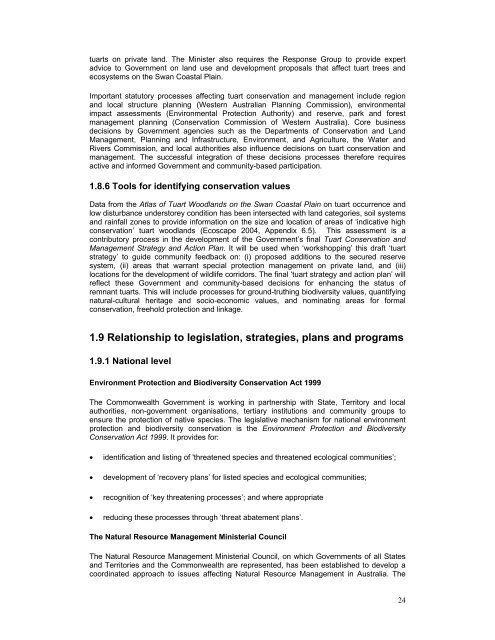DRAFT Tuart Conservation and Management Strategy
DRAFT Tuart Conservation and Management Strategy
DRAFT Tuart Conservation and Management Strategy
You also want an ePaper? Increase the reach of your titles
YUMPU automatically turns print PDFs into web optimized ePapers that Google loves.
tuarts on private l<strong>and</strong>. The Minister also requires the Response Group to provide expert<br />
advice to Government on l<strong>and</strong> use <strong>and</strong> development proposals that affect tuart trees <strong>and</strong><br />
ecosystems on the Swan Coastal Plain.<br />
Important statutory processes affecting tuart conservation <strong>and</strong> management include region<br />
<strong>and</strong> local structure planning (Western Australian Planning Commission), environmental<br />
impact assessments (Environmental Protection Authority) <strong>and</strong> reserve, park <strong>and</strong> forest<br />
management planning (<strong>Conservation</strong> Commission of Western Australia). Core business<br />
decisions by Government agencies such as the Departments of <strong>Conservation</strong> <strong>and</strong> L<strong>and</strong><br />
<strong>Management</strong>, Planning <strong>and</strong> Infrastructure, Environment, <strong>and</strong> Agriculture, the Water <strong>and</strong><br />
Rivers Commission, <strong>and</strong> local authorities also influence decisions on tuart conservation <strong>and</strong><br />
management. The successful integration of these decisions processes therefore requires<br />
active <strong>and</strong> informed Government <strong>and</strong> community-based participation.<br />
1.8.6 Tools for identifying conservation values<br />
Data from the Atlas of <strong>Tuart</strong> Woodl<strong>and</strong>s on the Swan Coastal Plain on tuart occurrence <strong>and</strong><br />
low disturbance understorey condition has been intersected with l<strong>and</strong> categories, soil systems<br />
<strong>and</strong> rainfall zones to provide information on the size <strong>and</strong> location of areas of ‘indicative high<br />
conservation’ tuart woodl<strong>and</strong>s (Ecoscape 2004, Appendix 6.5). This assessment is a<br />
contributory process in the development of the Government’s final <strong>Tuart</strong> <strong>Conservation</strong> <strong>and</strong><br />
<strong>Management</strong> <strong>Strategy</strong> <strong>and</strong> Action Plan. It will be used when ‘workshopping’ this draft ‘tuart<br />
strategy’ to guide community feedback on: (i) proposed additions to the secured reserve<br />
system, (ii) areas that warrant special protection management on private l<strong>and</strong>, <strong>and</strong> (iii)<br />
locations for the development of wildlife corridors. The final ‘tuart strategy <strong>and</strong> action plan’ will<br />
reflect these Government <strong>and</strong> community-based decisions for enhancing the status of<br />
remnant tuarts. This will include processes for ground-truthing biodiversity values, quantifying<br />
natural-cultural heritage <strong>and</strong> socio-economic values, <strong>and</strong> nominating areas for formal<br />
conservation, freehold protection <strong>and</strong> linkage.<br />
1.9 Relationship to legislation, strategies, plans <strong>and</strong> programs<br />
1.9.1 National level<br />
Environment Protection <strong>and</strong> Biodiversity <strong>Conservation</strong> Act 1999<br />
The Commonwealth Government is working in partnership with State, Territory <strong>and</strong> local<br />
authorities, non-government organisations, tertiary institutions <strong>and</strong> community groups to<br />
ensure the protection of native species. The legislative mechanism for national environment<br />
protection <strong>and</strong> biodiversity conservation is the Environment Protection <strong>and</strong> Biodiversity<br />
<strong>Conservation</strong> Act 1999. It provides for:<br />
• identification <strong>and</strong> listing of 'threatened species <strong>and</strong> threatened ecological communities’;<br />
• development of ‘recovery plans’ for listed species <strong>and</strong> ecological communities;<br />
• recognition of ‘key threatening processes’; <strong>and</strong> where appropriate<br />
• reducing these processes through ‘threat abatement plans’.<br />
The Natural Resource <strong>Management</strong> Ministerial Council<br />
The Natural Resource <strong>Management</strong> Ministerial Council, on which Governments of all States<br />
<strong>and</strong> Territories <strong>and</strong> the Commonwealth are represented, has been established to develop a<br />
coordinated approach to issues affecting Natural Resource <strong>Management</strong> in Australia. The<br />
24

















